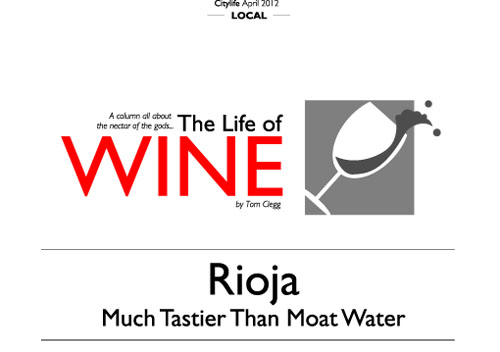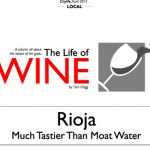
Last month we took a little look at a famous Portuguese footballer, erratic driving and tarts. This month, not because I’ve run out of ideas or anything, we are taking a left over the border into the north of Spain and having a quick peek at Rioja.
Rioja is fascinating on at least two levels. Firstly it produces some of the finest red wines on the planet, and secondly the name has a ‘j’ where there should be a ‘k’. It is one of the world’s oldest wine growing regions, where records of men in robes stamping on grapes – when they probably should have been illuminating manuscripts or bullying their congregations – stretch back to a time when the years only had three digits in them.
Although Rioja produces some interesting white wines and rosés, it is the reds for which it is most famous. The grape in charge here is Tempranillo – which rather oddly has a double ‘l’ where there should be a ‘y’. This is a delicious grape, capable of creating wines which benefit from a long period of ageing with good levels of acidity and alcohol which are smooth, fruity and velvety in the mouth. A bit of balance is often given through the addition of a portion of Garnacha grape juice.
Rioja has three distinct areas with their own characteristics. Rioja Alavesa in the north which has chalky soils and an Atlantic climate and produces full bodied wines; Rioja Alta which also has an Atlantic climate and is higher and cooler than the other areas and produces lighter, old style wines; and Rioja Baja which is hotter and drier and has a ‘j’ which is not a ‘j’ (or a ‘k’) but a bit of an ‘h’ with a touch of ‘c’ and just the tiniest hint of a ‘y’ all mixed up.
The wines are commonly a blend of juice from all three areas with alcohol and body coming from the barrels in Baja, complexity poured in from Alta and the structure mixed in from the vineyards in Alavesa.
Rioja’s classic vanilla spiciness comes from the fact that nearly all of the reds spend at least part of their lives hiding out in smallish barrels. The next bit’s a tad dull, but important to get a handle on when choosing a bottle of this superb wine.
There are four main types of Rioja depending how long the wine has been aged. Although it depends on where the wine was made, the rule is pretty much that young Rioja means less than a year in wood and that the wines are particularly fruity and meant to be drunk soon after they go into the bottle. The word Crianza on the label means the wine is two years old and has spent at least a year developing its flavour in oak. Reserva means the grapes have been chosen from a good vintage and are at least three years old with a year in wood, and Gran Reserva means an excellent vintage, two years in the barrel, and three years in the bottle.
Although the very finest examples of this wine can command a bit of a punch when it comes to price, Rioja’s are often far less painful on the wallet than poorer wines coming out of Bordeaux which, by the way, has an ‘a’, ‘u’ and an ‘x’ where there ought to be an ‘o’.
Another great thing about Rioja, and the reason for the title of this piece, is the Batalla de Vino which is held every summer in the town of Haro. The festival is strikingly similar to Songkran in Chiang Mai, but instead of moat water being thrown from buckets and squirted from super-soakers it is rather more pleasant tasting red wine. So, later this month, let’s all celebrate by throwing some of Spain’s finest, even if it is only down our necks.
